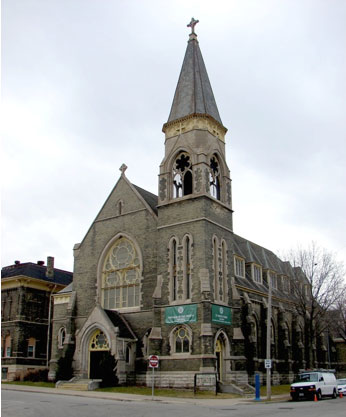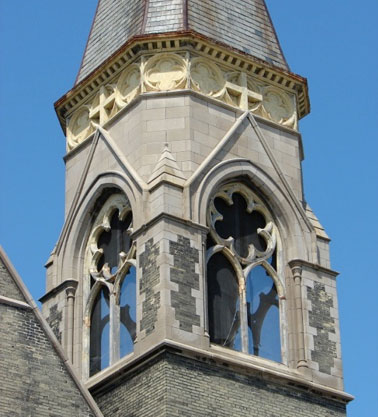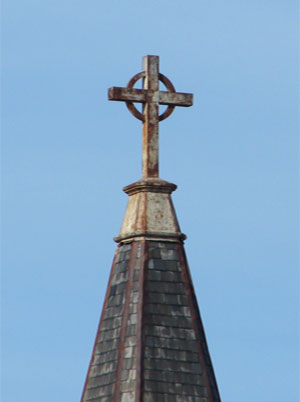34. St. Patrick’s Catholic, 1893
1105 South 7th Street (at Washington Street)
Architect: James Egan (Chicago)
St. Patrick’s Parish, organized in 1876, was the first parish on Milwaukee’s South Side for English-speaking Catholics. (Immaculate Conception in Bay View was founded in 1871 for English-speaking Catholics, but Bay View was not annexed by the City of Milwaukee until 1887.) The original members of St. Patrick’s were mainly Irish immigrants and their American-born children, although the parish later attracted some of the more assimilated members of the South Side’s German and Polish communities. The parish built a combination church and school in 1876, which is still standing to the immediate south of the current church. Construction of the current church began in 1893 and was completed in the spring of 1895.
The architect of the church, James J. Egan (1839-1914), was born and grew up in Cork, Ireland, where he attended Queens College. Immigrating to the United States in the 1860s, Egan worked in the New York offices of Richard Upjohn and Edward T. Potter. Both of these architects were prominent designers of Gothic Revival churches. Egan moved to Chicago just after that city’s fire of 1871, where he had a successful practice under his own name and in various partnerships with other architects. He designed numerous Catholic churches in Chicago, other Midwestern states, and more distant locations including Pittsburgh and San Francisco. St. Patrick’s is Egan’s only church in Milwaukee, but he also designed St. Thomas Catholic Church in Beloit, constructed in 1885.
St. Patrick’s has a Celtic cross atop the steeple and also at the peak of the façade gable. On the interior, the plaster ceiling vaults are decorated with Celtic interlaced designs in green and gold. This decorative painting was done in 1951 and restored in 1976. As in several of Milwaukee’s other Catholic churches, the stained glass windows were produced by the Tyrolean Art Glass Company of Innsbruck, Austria. The windows were installed at the time of the building’s construction.
The worship space is unusually wide for having no interior columns. The open interior not only provides unobstructed views from any pew, but also gives the church a feeling of spaciousness beyond that of some larger churches. Among the city’s Gothic Revival churches without interior columns, only Immanuel Presbyterian is wider than St. Patrick’s, and the Presbyterian church did have interior columns originally.
Some Spanish-speaking residents of the South Side, primarily Puerto Ricans, began to attend St. Patrick’s in the 1960s. The first Spanish Mass was celebrated in November of 1969, and from the early 1970s the church also offered baptisms, weddings, and funerals in Spanish. By 1980, Latin American immigrants and their children made up 80 percent of the parishioners at St. Patrick’s. The church currently offers regular Masses in both English and Spanish.
Sources:
“Blessed by the Bishop,” Milwaukee Sentinel, May 20, 1895, page 3, column 3.
Faith Journey: the First Hundred Years of a Pilgrim People. St. Patrick’s, Milwaukee, Wisconsin. St. Patrick’s Catholic Church, 1976.
Flower, Frank A. History of Milwaukee, Wisconsin. Chicago: Western Historical Company, 1881. Facsimile reprint by the Milwaukee Genealogical Society, 1981. Pages 915-16.
Mary Ellen Young Papers, Milwaukee County Historical Society Archives.
Pokorny, Gary. “Ministry to Hispanics in the Archdiocese of Milwaukee,” in Milwaukee Catholicism, edited by Steven M. Avella. Knights of Columbus, 1991.
St. Patrick’s Parish. St. Patrick’s Parish, 1976.



